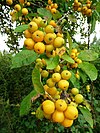Malus florentina
| Malus florentina | |
|---|---|

| |
| Scientific classification | |
| Kingdom: | Plantae |
| Clade: | Tracheophytes |
| Clade: | Angiosperms |
| Clade: | Eudicots |
| Clade: | Rosids |
| Order: | Rosales |
| Family: | Rosaceae |
| Genus: | Malus |
| Species: | M. florentina
|
| Binomial name | |
| Malus florentina | |
| Synonyms | |
|
Crataegus florentina | |
Malus florentina is a species of apple known by the common names Florentine crabapple and hawthorn-leaf crabapple. It is native to the Balkan Peninsula and Italy, and it is grown elsewhere as an ornamental tree.
Etymology[]
The botanical name florentina and common name florentine are remarking the source of the municipality of Florence, Italy that has a major history of botanical collection in their famous Renaissance gardens, and the other common name hawthorn-leaf is remarking its distinct toothed[1] leaf shape which closely resembles that of a hawthorn and is unusual for a crabapple.
Description[]

Tree is deciduous, upright and vase shaped,[1] growing up to 8 m (26 ft) by 6 m (19 ft). It is cold hardy to 4 and USDA hardiness zone 4–8, and is not frost tender. It blossoms in June, and the seeds ripen from October to November.[2] Flowers appear in corymbs.[1]
Fruit is oval, about 15mm long and 8mm wide, it ripens in mid autumn and usually bletts on the tree.
Consumption[]
Can be eaten raw or cooked. When bletted, it has a mealy texture with a soft acid flesh, is refreshing in small quantities. Seed of all crabapple contain hydrogen cyanide that can be toxic if consumed in large quantities.[2]
Cultivation[]
Suitable for all kind of soils, with all levels of pH values, but prefers moist or wet soil that is well drained. Prefers full sun but can also manage when semi-shaded.[2][1]
References[]
- ^ a b c d Backyard Gardener
- ^ a b c Plants for a Future
External links[]
![]() Media related to Malus florentina at Wikimedia Commons
Media related to Malus florentina at Wikimedia Commons
- Malus
- Crabapples
- Flora of Italy
- Flora of Southeastern Europe
